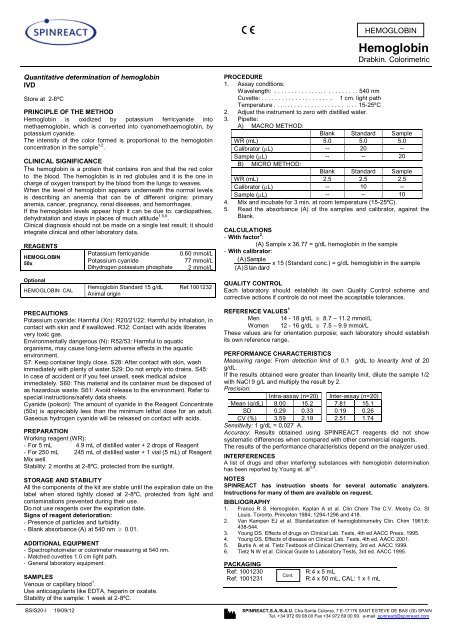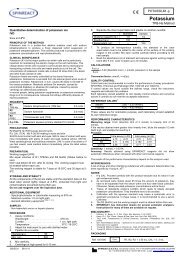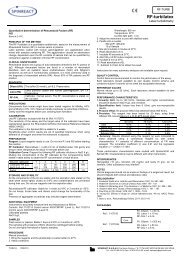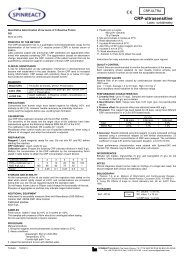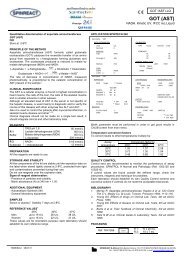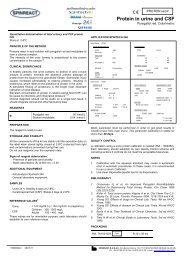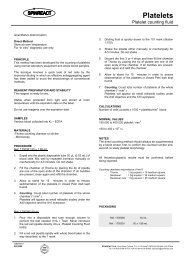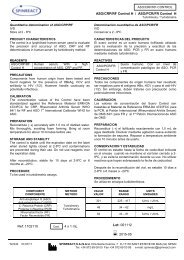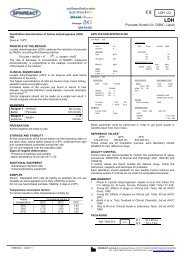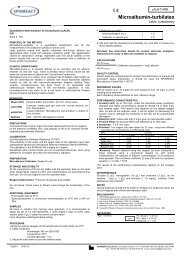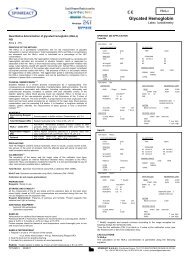Hemoglobin
Hemoglobin - Spinreact
Hemoglobin - Spinreact
- No tags were found...
Create successful ePaper yourself
Turn your PDF publications into a flip-book with our unique Google optimized e-Paper software.
HEMOGLOBIN<br />
<strong>Hemoglobin</strong><br />
Drabkin. Colorimetric<br />
Quantitative determination of hemoglobin<br />
IVD<br />
Store at 2-8ºC<br />
PRINCIPLE OF THE METHOD<br />
<strong>Hemoglobin</strong> is oxidized by potassium ferricyanide into<br />
methaemoglobin, which is converted into cyanomethaemoglobin, by<br />
potassium cyanide.<br />
The intensity of the color formed is proportional to the hemoglobin<br />
concentration in the sample 1,2 .<br />
CLINICAL SIGNIFICANCE<br />
The hemoglobin is a protein that contains iron and that the red color<br />
to the blood. The hemoglobin is in red globules and it is the one in<br />
charge of oxygen transport by the blood from the lungs to weaves.<br />
When the level of hemoglobin appears underneath the normal levels<br />
is describing an anemia that can be of different origins: primary<br />
anemia, cancer, pregnancy, renal diseases, and hemorrhages.<br />
If the hemoglobin levels appear high it can be due to: cardiopathies,<br />
dehydratation and stays in places of much altitude 1,5,6 .<br />
Clinical diagnosis should not be made on a single test result; it should<br />
integrate clinical and other laboratory data.<br />
REAGENTS<br />
HEMOGLOBIN<br />
50x<br />
Potassium ferricyanide<br />
Potassium cyanide<br />
Dihydrogen potassium phosphate<br />
0.60 mmol/L<br />
77 mmol/L<br />
2 mmol/L<br />
PROCEDURE<br />
1. Assay conditions:<br />
Wavelength: . . . . . . . . . . . . . .. . . . . . . . . . . 540 nm<br />
Cuvette: . . . . . . . . . . . . . . . . . . . . .. 1 cm. light path<br />
Temperature . . . . . . . . . . . . . . . . . . . . . .. . . 15-25ºC<br />
2. Adjust the instrument to zero with distilled water.<br />
3. Pipette:<br />
A) MACRO METHOD:<br />
Blank Standard Sample<br />
WR (mL) 5.0 5.0 5.0<br />
Calibrator ( L) -- 20 --<br />
Sample ( L) -- -- 20<br />
B) MICRO METHOD:<br />
Blank Standard Sample<br />
WR (mL) 2.5 2.5 2.5<br />
Calibrator ( L) -- 10 --<br />
Sample ( L) -- -- 10<br />
4. Mix and incubate for 3 min. at room temperature (15-25ºC).<br />
5. Read the absorbance (A) of the samples and calibrator, against the<br />
Blank.<br />
CALCULATIONS<br />
- With factor 2 :<br />
(A) Sample x 36.77 = g/dL hemoglobin in the sample<br />
- With calibrator:<br />
(A)Sample<br />
x 15 (Standard conc.) = g/dL hemoglobin in the sample<br />
(A)Stan dard<br />
Optional<br />
HEMOGLOBIN CAL<br />
<strong>Hemoglobin</strong> Standard 15 g/dL<br />
Animal origin<br />
Ref.1001232<br />
QUALITY CONTROL<br />
Each laboratory should establish its own Quality Control scheme and<br />
corrective actions if controls do not meet the acceptable tolerances.<br />
PRECAUTIONS<br />
Potassium cyanide: Harmful (Xn): R20/21/22: Harmful by inhalation, in<br />
contact with skin and if swallowed. R32: Contact with acids liberates<br />
very toxic gas.<br />
Environmentally dangerous (N): R52/53: Harmful to aquatic<br />
organisms, may cause long-term adverse effects in the aquatic<br />
environment.<br />
S7: Keep container tingly close. S28: After contact with skin, wash<br />
immediately with plenty of water.S29: Do not empty into drains. S45:<br />
In case of accident or if you feel unwell, seek medical advice<br />
immediately. S60: This material and its container must be disposed of<br />
as hazardous waste. S61: Avoid release to the environment. Refer to<br />
special instructions/safety data sheets.<br />
Cyanide (poison): The amount of cyanide in the Reagent Concentrate<br />
(50x) is appreciably less than the minimum lethal dose for an adult.<br />
Gaseous hydrogen cyanide will be released on contact with acids.<br />
PREPARATION<br />
Working reagent (WR):<br />
- For 5 mL 4.9 mL of distilled water + 2 drops of Reagent<br />
- For 250 mL 245 mL of distilled water + 1 vial (5 mL) of Reagent<br />
Mix well.<br />
Stability: 2 months at 2-8ºC, protected from the sunlight.<br />
STORAGE AND STABILITY<br />
All the components of the kit are stable until the expiration date on the<br />
label when stored tightly closed at 2-8ºC, protected from light and<br />
contaminations prevented during their use.<br />
Do not use reagents over the expiration date.<br />
Signs of reagent deterioration:<br />
- Presence of particles and turbidity.<br />
- Blank absorbance (A) at 540 nm 0.01.<br />
ADDITIONAL EQUIPMENT<br />
- Spectrophotometer or colorimeter measuring at 540 nm.<br />
- Matched cuvettes 1.0 cm light path.<br />
- General laboratory equipment.<br />
SAMPLES<br />
Venous or capillary blood 1 .<br />
Use anticoagulants like EDTA, heparin or oxalate.<br />
Stability of the sample: 1 week at 2-8ºC.<br />
REFERENCE VALUES 1<br />
Men 14 - 18 g/dL 8.7 – 11.2 mmol/L<br />
Women 12 - 16 g/dL 7.5 – 9.9 mmol/L<br />
These values are for orientation purpose; each laboratory should establish<br />
its own reference range.<br />
PERFORMANCE CHARACTERISTICS<br />
Measuring range: From detection limit of 0.1 g/dL to linearity limit of 20<br />
g/dL.<br />
If the results obtained were greater than linearity limit, dilute the sample 1/2<br />
with NaCl 9 g/L and multiply the result by 2.<br />
Precision:<br />
Intra-assay (n=20) Inter-assay (n=20)<br />
Mean (g/dL) 8.00 15.2 7.81 15.1<br />
SD 0.29 0.33 0.19 0.26<br />
CV (%) 3.59 2.19 2.51 1.74<br />
Sensitivity: 1 g/dL = 0,027 A.<br />
Accuracy: Results obtained using SPINREACT reagents did not show<br />
systematic differences when compared with other commercial reagents.<br />
The results of the performance characteristics depend on the analyzer used.<br />
INTERFERENCES<br />
A list of drugs and other interfering substances with hemoglobin determination<br />
has been reported by Young et. al 3,4 .<br />
NOTES<br />
SPINREACT has instruction sheets for several automatic analyzers.<br />
Instructions for many of them are available on request.<br />
BIBLIOGRAPHY<br />
1. Franco R S. <strong>Hemoglobin</strong>. Kaplan A et al. Clin Chem The C.V. Mosby Co. St<br />
Louis. Toronto. Princeton 1984; 1294-1296 and 418.<br />
2. Van Kampen EJ et al. Standarization of hemoglobinometry Clin. Chim 1961;6:<br />
438-544.<br />
3. Young DS. Effects of drugs on Clinical Lab. Tests, 4th ed AACC Press, 1995.<br />
4. Young DS. Effects of disease on Clinical Lab. Tests, 4th ed. AACC 2001.<br />
5. Burtis A. et al. Tietz Textbook of Clinical Chemistry, 3rd ed. AACC 1999.<br />
6. Tietz N W et al. Clinical Guide to Laboratory Tests, 3rd ed. AACC 1995.<br />
PACKAGING<br />
Ref: 1001230<br />
Ref: 1001231<br />
Cont.<br />
.<br />
R:4 x 5 mL<br />
R:4 x 50 mL, CAL: 1 x 1 mL<br />
BSIS20-I 19/09/12 SPINREACT,S.A./S.A.U. Ctra.Santa Coloma, 7 E-17176 SANT ESTEVE DE BAS (GI) SPAIN<br />
Tel. +34 972 69 08 00 Fax +34 972 69 00 99. e-mail: spinreact@spinreact.com
HEMOGLOBIN<br />
<strong>Hemoglobin</strong>a<br />
Drabkin. Colorimétrico<br />
Determinación cuantitativa de hemoglobina<br />
IVD<br />
Conservar a 2-8ºC<br />
PRINCIPIO DEL METODO<br />
La hemoglobina es oxidada por la acción del ferricianuro a<br />
metahemoglobina y mediante el cianuro se convierte en<br />
cianmetahemoglobina.<br />
La intensidad del color formado es proporcional a la concentración de<br />
hemoglobina presente en la muestra ensayada 1,2 .<br />
SIGNIFICADO CLINICO<br />
La hemoglobina es una proteína que contiene hierro, otorga el color rojo a<br />
la sangre. Se encuentra en los glóbulos rojos y es la encargada del<br />
transporte de oxigeno por la sangre desde los pulmones a los tejidos.<br />
Cuando el nivel de hemoglobina aparece por debajo de los niveles<br />
normales indica anemia que puede obedecer a diferentes causas: anemia<br />
primaria, cáncer, embarazo, enfermedades renales o hemorragias.<br />
Si el nivel de hemoglobina es alto puede deberse a cardiopatías,<br />
deshidratación o estancia en lugares de gran altitud 1,5,6 .<br />
El diagnostico clínico debe realizarse teniendo en cuenta todos los datos<br />
clínicos y de laboratorio.<br />
REACTIVOS<br />
HEMOGLOBIN<br />
50x<br />
Opcional<br />
HEMOGLOBIN CAL<br />
Ferricianuro de potasio<br />
Cianuro de potasio<br />
Dihidrogeno fosfato de potasio<br />
Patrón de <strong>Hemoglobin</strong>a 15 g/dL<br />
Origen animal<br />
0,60 mmol/L<br />
77 mmol/L<br />
2 mmol/L<br />
Ref.1001232<br />
PRECAUCIONES<br />
Cianuro de potasio: Nocivo (Xn): R20/21/22: Nocivo por inhalación, por<br />
ingestión y en contacto con la piel. R32: En contacto con ácidos libera<br />
gases muy tóxicos.<br />
Peligroso para el medio ambiente (N): R52/53: Nocivo para los<br />
organismos acuáticos, puede provocar a largo plazo efectos negativos en<br />
el medio ambiente acuático.<br />
S7: Manténgase el recipiente bien cerrado. S28: En contacto con la piel,<br />
lavar inmediatamente y abundantemente con agua. S29: No tirar los<br />
residuos por el desagüe.S45: En caso de accidente o malestar, acudir<br />
inmediatamente al medico. S60: Elimínese el producto y su recipiente<br />
como residuos peligrosos. S61: Evítese su liberación al medio ambiente.<br />
Recábense instrucciones específicas/ las fichas de datos de seguridad.<br />
Cianuro (venenoso): La concentración de cianuro en el Reactivo<br />
concentrado (50x) es sensiblemente menor que la dosis mínima letal para<br />
el adulto. Su acidificación puede provocar liberación de ácido cianhídrico.<br />
PREPARACION<br />
Reactivo de trabajo (RT):<br />
- Para 5 mL 4,9 mL agua destilada + 2 gotas de Reactivo<br />
- Para 250 mL 245 mL agua destilada + 1 frasco (5 mL) de Reactivo<br />
Mezclar bien.<br />
Estabilidad: 2 meses en nevera a 2-8ºC, protegido de la luz.<br />
CONSERVACION Y ESTABILIDAD<br />
Todos los componentes del kit son estables, hasta la fecha de<br />
caducidad indicada en la etiqueta del vial, cuando se mantienen los<br />
viales bien cerrados a 2-8ºC, protegidos de la luz y se evita la<br />
contaminación durante su uso.<br />
No usar reactivos fuera de la fecha indicada.<br />
Indicadores de deterioro de los reactivos:<br />
- Presencia de partículas y turbidez.<br />
- Absorbancia (A) del Blanco a 540 nm 0,01.<br />
MATERIAL ADICIONAL<br />
- Espectrofotómetro o analizador para lecturas a 540 nm.<br />
- Cubetas de 1,0 cm de paso de luz.<br />
- Equipamiento habitual de laboratorio.<br />
MUESTRAS<br />
Sangre capilar o venosa 1 .<br />
Usar anticoagulantes como EDTA, heparina u oxalato.<br />
Estabilidad de la muestra: 1 semana a 2-8ºC.<br />
PROCEDIMIENTO<br />
1. Condiciones del ensayo:<br />
Longitud de onda: . . . . . . . . . . . . . . . . . . . . . . . 540 nm<br />
Cubeta:. . . . . . . . . . . . . . . . . . . . . . . .. .1 cm paso de luz<br />
Temperatura . . . . . . . . . . . . . . . . . . . . . .. . . .. . . 15-25ºC<br />
2. Ajustar el espectrofotómetro a cero frente a agua destilada.<br />
3. Pipetear:<br />
A) METODO MACRO<br />
Blanco Patrón Muestra<br />
RT (mL) 5,0 5,0 5,0<br />
Calibrador ( L) -- 20 --<br />
Muestra ( L) -- -- 20<br />
B) METODO MICRO<br />
Blanco Patrón Muestra<br />
RT (mL) 2.5 2.5 2.5<br />
Calibrador ( L) -- 10 --<br />
Muestra ( L) -- -- 10<br />
4. Mezclar e incubar 3 minutos a temperatura ambiente (15-25ºC).<br />
5. Leer la absorbancia (A) del calibrador y la muestra, frente al Blanco<br />
de reactivo.<br />
CALCULOS<br />
- Con factor 2 :<br />
(A) Muestra x 36,77 = g/dL de hemoglobina en la muestra<br />
- Con Patrón:<br />
(A)Muestra<br />
x 15 (Conc. Patrón) = g/dL de hemoglobina en la muestra<br />
(A)Patrón<br />
CONTROL DE CALIDAD<br />
Cada laboratorio debe disponer su propio Control de Calidad y establecer<br />
correcciones en el caso de que los controles no cumplan con las tolerancias.<br />
VALORES DE REFERENCIA 1<br />
Hombres 14 - 18 g/dL 8,7 - 11,2 mmol/L<br />
Mujeres 12 - 16 g/dL 7,5 - 9,9 mmol/L<br />
Estos valores son orientativos. Es recomendable que cada laboratorio<br />
establezca sus propios valores de referencia.<br />
CARACTERISTICAS DEL METODO<br />
Rango de medida: Desde el limite de detección de 0,1 g/dL hasta el limite<br />
de linealidad de 20 g/dL.<br />
Si la concentración de la muestra es superior al limite de linealidad, diluir<br />
1/2 con ClNa 9 g/L y multiplicar el resultado final por 2.<br />
Precisión:<br />
Intraserie (n= 20) Interserie (n= 20)<br />
Media (g/dL) 8,00 15,2 7,81 15,1<br />
SD 0,29 0,33 0,19 0,26<br />
CV (%) 3,59 2,19 2,51 1,74<br />
Sensibilidad analítica: 1 g/dL = 0,027 A.<br />
Exactitud: Los reactivos de SPINREACT no muestran diferencias<br />
sistemáticas significativas cuando se comparan con otros reactivos<br />
comerciales.<br />
Las características del método pueden variar según el analizador utilizado.<br />
INTERFERENCIAS<br />
Se han descrito varias drogas y otras substancias que interfieren en la<br />
determinación de la hemoglobina 3,4 .<br />
NOTAS<br />
SPINREACT dispone de instrucciones detalladas para la aplicación de este<br />
reactivo en distintos analizadores.<br />
BIBLIOGRAFIA<br />
1. Franco R S. <strong>Hemoglobin</strong>. Kaplan A et al. Clin Chem The C.V. Mosby Co. St Louis.<br />
Toronto. Princeton 1984; 1294-1296 and 418.<br />
2. Van Kampen EJ et al. Standarization of hemoglobinometry Clin. Chim 1961;6: 438-544.<br />
3. Young DS. Effects of drugs on Clinical Lab. Tests, 4th ed AACC Press, 1995.<br />
4. Young DS. Effects of disease on Clinical Lab. Tests, 4th ed. AACC 2001.<br />
5. Burtis A. et al. Tietz Textbook of Clinical Chemistry, 3rd ed. AACC 1999.<br />
6. Tietz N W et al. Clinical Guide to Laboratory Tests, 3rd ed. AACC 1995.<br />
PRESENTACION<br />
Ref: 1001230<br />
Ref: 1001231<br />
Cont.<br />
.<br />
R:4 x 5 mL<br />
R:4 x 50 mL, CAL: 1 x 1 mL<br />
BSIS20-E 19/09/12 SPINREACT,S.A./S.A.U. Ctra.Santa Coloma, 7 E-17176 SANT ESTEVE DE BAS (GI) SPAIN<br />
Tel. +34 972 69 08 00 Fax +34 972 69 00 99. e-mail: spinreact@spinreact.com


